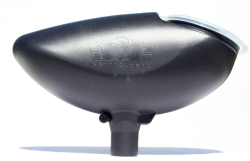Description
A paintball hopper is a device that holds paintballs for a paintball marker. Hoppers can be gravity fed, agitated feed, or force fed. Gravity feed hoppers often get jammed up with balls at the feed neck, which can result in a marker "dry firing" (firing without paint) or chopping balls due to the timing of the ball entering the marker. Agitated feed hoppers improve on the Gravity method of feeding the marker. Some use simple agitation levers or paddles inside the hopper to shake up the balls and guide them down the feed neck. Others (sometimes colloquially known as "reviews") use a paddle wheel inside the hopper to force any balls reaching the bottom of the hopper into the feed neck. Agitated Feeders need gravity to keep the balls rolling toward the bottom of the hopper before they can reach the loading mechanism. The "Revo" with "Z-Board" uses an electric motor to spin the paddle wheel at high speed and this method remains one of the fastest loading systems as of March 2013. Force feed loaders create a stack of paint balls leading into the marker. Most of these hoppers maintain a constant tension on the ball stack to ensure that once a paintball is fired
Hoppers contain the paintball supply for a marker, much as magazines contain the ammunition on a regular rifle. With few exceptions, hoppers are all mounted above the marker, and most use gravity as the ultimate force to get the balls in the marker. That is to say, if most hoppers are turned upside down, the marker will not be fed with balls and will cease to fire.
There are three main types: Gravity Feed, Agitated Feed, and Force Feed loaders.
Gravity Feed hoppers often get jammed up with balls at the feed neck, which can result in a marker ‘dry firing’ (firing without paint) or chopping balls due to the timing of the ball entering the marker. This is detrimental to the speed and performance of the marker.
Agitated Feed hoppers improve on the Gravity method of feeding the marker. Some use simple agitation levers or paddles inside the hopper to shake up the balls and guide them down the feed neck. Others (sometimes colloquially known as ‘revies’) use a paddle wheel inside the hopper to force any balls reaching the bottom of the hopper into the feed neck. Agitated Feeders need gravity to keep the balls rolling toward the bottom of the hopper before they can reach the loading mechanism. The ‘Revo’ with ‘Z-Board’ uses an electric motor to spin the paddle wheel at high speed and this method remains one of the fastest loading systems as of March 2013.
Force Feed loaders create a stack of paint balls leading into the marker. Most of these hoppers maintain a constant tension on the ball stack to ensure that once a paintball is fired, a new one immediately takes its place. A special feed tube is sometimes used to allow placement of a hopper below the chamber, giving the marker a much lower profile. Any hopper-based loading system still relies on gravity to get paint into the drive portion of the loader itself. The ‘Warp’ loader uses an electric motor to rotate two silicone discs with ball-shaped divots, which add each ball to a stack headed down the feed tube into the chamber.
